Kami Shiroi Nishi Ikuma:
Did people move from the Setouchi region into the interior of Kantō?
A cluster of stone tools, made with the Setouchi technique, completely refitted as the original stones.
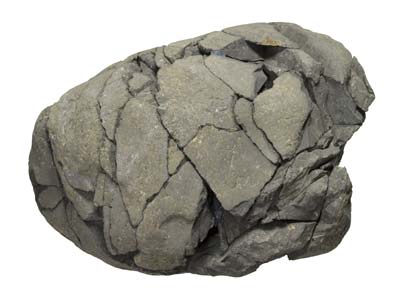
Material refitted to the shape of the original stone Refitting 148 pieces enabled reconstruction close to the form of the source stone. Even while encountering accidental breaks at unintended places, 5 board-shaped flakes were struck from it. By removing the 148 pieces one by one, a reenactment can be seen of the steps of stone tool making from the Paleolithic period. Length: 21.3 cm. |
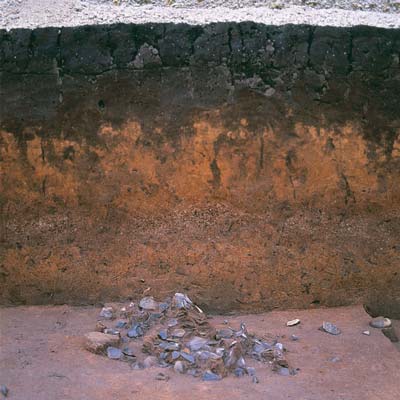
Stone tools recovered in clusters At places where they clustered, stone tools were found piled one upon another. The whitish area visible in the section above is the Asama Shiraito pumice (which fell 18,000 years BP). The tools were recovered from beneath the pumice layer. |
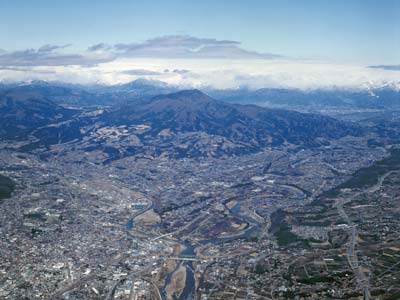
A view of the site from the plain to the south Mt. Komochi is to the front, with the mountains forming the border between Gunma and Niigata prefectures visible to the rear. On the right (east) flows the Tone river, and the Azuma river converges with it from the left (west). A straight line of trees densely covering the slope of a terrace is visible on the Tone's west bank, and the site was discovered directly below this (arrow). |

Steps of the Setouchi technique The technique divides into a first step of taking a board-shaped flake from the source stone, a second step of obtaining from it long flakes in the shape of a bird's outstretched wing, and a third step of making a Kou-type knife from the wing-shaped flake. As all three steps were detected at the Kami Shiroi Nishi Ikuma site, the entire process of taking raw stone and producing from it knife-shaped stone tools is seen to have been conducted. Adapted from Hakkutsu sareta Nihon rettō 2010 [Excavations in the Japanese Archipelago, 2010] (Bunkachō [Agency for Cultural Affairs], ed., Asahi Shimbun Publications, 2010). |
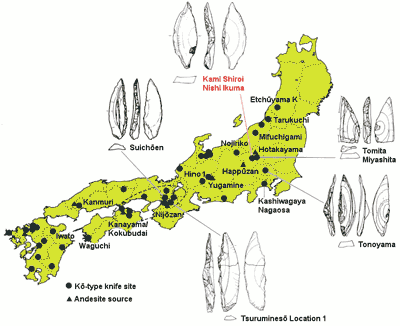
Principal sites yielding Kou-type knives Centering on the border between Osaka and Nara prefecture, and on central Setouchi, these items are distributed from Kyushu to the Tōhoku region. On Honshu, many are found on the Japan Sea side. The strong tendency to select varieties of andesite is also characteristic. Adapted from Hakkutsu sareta Nihon rettō 2010 [Excavations in the Japanese Archipelago, 2010] (Bunkachō [Agency for Cultural Affairs], ed., Asahi Shimbun Publications, 2010); based on Kyūsekki kōkogaku jiten [Dictionary of Paleolithic archaeology] (Kyūsekki Bunka Danwakai, ed., Gakuseisha, 2007). | |
Kami Shiroi Nishi Ikuma Site, Shibukawa City, Gunma Prefecture
Stone tools recovered in clusters
This site is an Upper Paleolithic stone tool-manufacturing location. It sits atop a terrace 230 m in elevation, on the west bank of the Tone river, and in an excavation in 2004 more than 5,000 stone tools were found clustered together. The tools were mainly of black andesite and black shale, which can be collected from the Tone river, and were ascertained to lie in strata between the Asama Shiraito pumice layer (which fell 18,000 years BP) and the Maebashi mud flow (approximately 20,000 BP).
Reconstructed stone tool making of 20,000 years ago
Refitting the tools that were recovered, there were 8 cases for which it was possible to reconstruct the original source stone. After these were refitted into reconstructions, by removing flakes from the source stone in turn, we are able to observe some 20,000 years later a reenactment of the stone tool-making process. As a result, it was learned that stone tool making was done with the Setouchi technique which developed in the western Kinki and central Setouchi regions.
What is the Setouchi technique?
In order to make knife-shaped stone tools, the Setouchi technique is a method of repeatedly flaking wing-shaped pieces from a uniform direction, in the manner of slicing sashimi, off a large board-shaped flake, and can be divided broadly into three steps.
Apart from knife-shaped stone tools, scrapers and other worked flakes were made in the course of flaking, but there were no regularly shaped tools. The selection of andesite as the raw material is also characteristic of the Setouchi technique.
Rare in the Kantō region
The Setouchi technique, and the Kou-type knife it was used for making, are distributed from Kyushu to the Tōhoku region. East of the Kinki region, the trend is for greater numbers on the Japan Sea side.
In recent years, materials made with the Setouchi technique have drawn attention as clues for investigating the movements of human groups in the Upper Paleolithic period, and the manner in which information was transmitted. It is surely of great significance that these materials were found in Gunma prefecture, the midpoint between the Japan Sea and Pacific sides of the archipelago. (Ōnishi Masahiro)
Principal artifacts, Kami Shiroi Nishi Ikuma Site

Board-shaped flakes 
Knife-shaped stone tools of black shale
|
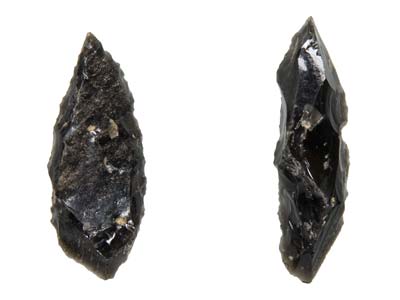
Pyramidal-point stone tools
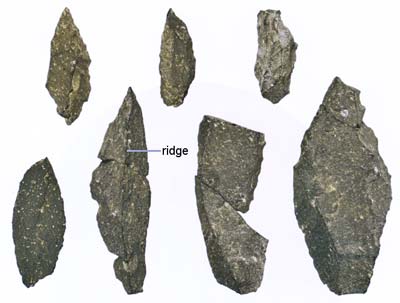
Knife-shaped stone tools of black andesite
|
Adapted from Hakkutsu sareta Nihon rettō 2010 [Excavations in the Japanese Archipelago, 2010] (Bunkachō [Agency for Cultural Affairs], ed., Asahi Shimbun Publications, 2010).
